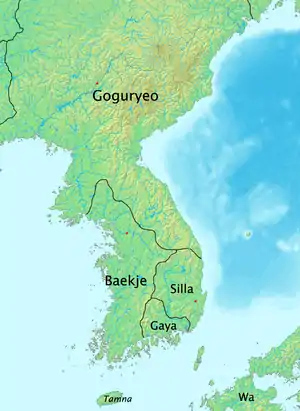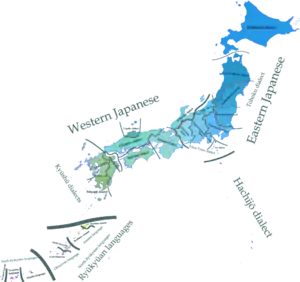Peninsular Japonic
Peninsular Japonic languages are now-extinct Japonic languages that many linguists believe were formerly spoken on the central and southern parts of the Korean Peninsula. The evidence consists of placenames listed in ancient texts, principally the Samguk sagi (compiled in 1145 based on earlier records).[1]
| Peninsular Japonic | |
|---|---|
| Para-Japonic | |
| Geographic distribution | Central and southern Korea |
| Extinct | 1st millennium CE |
| Linguistic classification | Japonic
|
| Glottolog | (not evaluated) |
 Korea in the late 4th century | |
Placename glosses in the Samguk sagi
The Samguk sagi is a history, written in Classical Chinese, of the Korean Three Kingdoms period, which ended in 668. Chapter 37 gives place names and meanings, mostly for places in the Goguryeo lands seized by Silla.[1] These glosses were first studied by Naitō Torajirō in 1907, with substantial analysis beginning with a series of articles by Lee Ki-Moon in the 1960s.[2][3]
For example, the following entry refers to the city now known as Suwon:[4]
買忽一云水城
'買忽 one [source] calls "water city"'
That is, the characters 買忽 are used to record the sound of the name, while the characters 水城 represent its meaning.[4] From this, we infer that 買 and 忽 represent the pronunciations of local words for 'water' and 'city' respectively.[5] In this way, a vocabulary of 80 to 100 words has been extracted from these place names.[6][7] Characters like 買 and 忽 presumably represented pronunciations based on some local version of the Chinese reading tradition, but there is no agreement on what this sounded like. One approximation is to use the Middle Chinese reading pronunciations recorded in such dictionaries as the Qieyun (compiled in 601), in which 買 is pronounced mɛ. Another uses the Sino-Korean readings of 15th century dictionaries of Middle Korean, yielding a pronunciation of may for the same character. In some cases, the same word is represented by several characters with similar pronunciations.[7]
Several of the words extracted from these names resemble Korean or Tungusic languages.[8] Others, including all four of the attested numerals, resemble Japonic languages, and are accepted by many authors as evidence that now-extinct relatives of Japonic were once spoken on the Korean peninsula.[9]
| Native word | Gloss | Old Japanese | ||
|---|---|---|---|---|
| Script | Middle Chinese[lower-alpha 1] | Sino-Korean[lower-alpha 2] | ||
| 密 | mit | mil | three | mi1[10][11] |
| 于次 | hju-tshijH | wucha | five | itu[10][12] |
| 難隱 | nan-ʔɨnX | nanun | seven | nana[10][13] |
| 德 | tok | tek | ten | to2wo[10][14] |
| 旦 | tanH | tan | valley | tani[15][16] |
| 頓 | twon | twon | ||
| 吞 | then | thon | ||
| 烏斯含 | ʔu-sje-hom | wosaham | rabbit | usagi1[17][18] |
| 那勿 | na-mjut | namwul | lead | namari[11][17] |
| 買 | mɛX | may | water | mi1(du) < *me[15][19][20] |
| 美 | mijX | may | ||
| 彌 | mjieX | mi | ||
The first authors to study these words assumed that, because these place names came from the territory of Goguryeo, they must have represented the language of that state.[21] Lee and Ramsey offer the additional argument that the dual use of Chinese characters to represent the sound and meaning of the place names must have been done by scribes of Goguryeo, which would have borrowed written Chinese earlier than the southern kingdoms.[22] They argue that the Goguryeo language formed a link between Japanese, Korean and Tungusic.[23]
Christopher I. Beckwith, applying his own Middle Chinese readings, claims that almost all of the words have Japonic cognates.[24] He takes this as the language of Goguryeo, which he considers a relative of Japanese in a family he calls Japanese-Koguryoic.[25] He suggests that the family was located in western Liaoning in the 4th century BC, with one group (identified with the Yayoi culture) travelling by sea to southern Korea and Kyushu, others migrating into eastern Manchuria and northern Korea, and others by sea to the Ryukyu Islands.[26] In a review for Korean Studies, Thomas Pellard criticizes Beckwith's linguistic analysis for the ad hoc nature of his Chinese reconstructions, for his handling of Japonic material and for hasty rejection of possible cognates in other languages.[27] Another review by historian Mark Byington casts doubt on Beckwith's interpretation of the documentary references on which his migration theory is based.[28]
Other authors point out that none of the placenames with proposed Japonic cognates are located in the historical homeland of Goguryeo north of the Taedong River, and no Japonic morphemes have been identified in inscriptions from the area, such as the Gwanggaeto Stele.[17][29] The glossed place names of the Samguk sagi generally come from central Korea, in an area captured by Goguryeo from Baekje and other states in the 5th century, and suggest that the place names reflect the languages of those states rather than that of Goguryeo.[30][31] This would explain why they seem to reflect multiple language groups.[32] Kōno Rokurō and Kim Bang-han have argued for bilingualism in Baekje, with the placenames reflecting the language of the common people.[33]
Other evidence
Several authors have suggested that the sole recorded word of the Gaya confederacy is Japonic.[34] Alexander Vovin has suggested Japonic etymologies for several words and placenames from southern Korea appearing in ancient Chinese and Korean texts.[35]
Baekje
As noted above, several authors believe that the glossed placenames of the Samguk sagi reflect an early language of Baekje. In addition, chapter 54 of the Book of Liang (635) gives four Baekje words, two of which may be compared to Japonic:[36]
- 固麻 kuHmæ 'ruling fortress' vs Old Japanese ko2m 'to put inside'
- 檐魯 yemluX 'settlement' vs Old Japanese ya 'house' and maro2 'circle'
Silla
Some words from Silla and its predecessor Jinhan are recorded by Chinese historians in chapter 30 of Wei Zhi in Records of the Three Kingdoms (3rd century) and chapter 54 of the Book of Liang (completed in 635). Many of these words appear to be Korean, but a few match Japonic forms, e.g. mura (牟羅) 'settlement' vs Old Japanese mura 'village'.[37]
Chapter 34 of the Samguk sagi gives former place names in Silla and the standardized two-character Sino-Korean names assigned under King Gyeongdeok in the 8th century. Many of the pre-reform names cannot be given Korean derivations, but are explicable as Japonic words. For example, several of them contain an element miti (彌知), which resembles Old Japanese mi1ti 'way, road'.[38]
Gaya
The Gaya confederacy maintained trading relations with Japan, until it was overrun by Silla in the early 6th century.[39] A single word is explicitly attributed to the Gaya language, in chapter 44 of the Samguk sagi:
加羅語謂門為梁云。
'In the Gaya language "gate" is called 梁.'
Because the character 梁 was used to transcribe the Silla word ancestral to Middle Korean twol 'ridge', philologists heve inferred that the Gaya word for 'gate' had a similar pronunciation. This word has been compared with the Old Japanese word to2 with the same meaning.[40][41]
Tamna
Vovin suggests that the ancient name for the kingdom of Tamna on Jeju Island, Tanmura or Tammura (𨈭牟羅), may have a Japonic etymology tani mura 'valley settlement' or tami mura 'people's settlement'.[42][43]
A village in southwestern Jeju called Gamsan (/kamsan/ 'persimmon mountain') has an old name 神山 'deity mountain'. The first character of the place name (神) cannot be read as gam/kam in Korean, but Vovin suggests that the first syllable was originally a word cognate to Old Japanese kami2 'deity'.[44]
The Jeju language is Koreanic, but may have a Japonic substratum. For example, the colloquial word kwulley 'mouth' may be connected to the Japonic word *kutu-i 'mouth'.[45]
Proposed archaeological links
Whitman associates the Japonic with the spread of wet rice agriculture via the Mumun culture of the Korean peninsula and the Yayoi culture of Japan. He further suggests that Koreanic arrived in the peninsula from the north with the Liaoning bronze dagger culture about 300 BCE.[46] Vovin proposes a similar model, but associates Koreanic with iron-using mounted warriors from Manchuria.[47]
Notes
- Middle Chinese forms are given using Baxter's transcription for Middle Chinese. The letters H and X denote Middle Chinese tone categories.
- Korean forms are cited using the Yale romanization of Korean.
References
- Lee & Ramsey (2011), p. 37.
- Toh (2005), p. 12.
- Beckwith (2004), p. 3.
- Lee & Ramsey (2011), pp. 37–38.
- Lee & Ramsey (2011), pp. 38–39.
- Lewin (1976), p. 408.
- Lee & Ramsey (2011), p. 39.
- Lee & Ramsey (2011), pp. 41, 43.
- Whitman (2011), pp. 153–154.
- Lee & Ramsey (2011), p. 43.
- Itabashi (2003), p. 147.
- Itabashi (2003), p. 154.
- Itabashi (2003), p. 148.
- Itabashi (2003), pp. 152–153.
- Lee & Ramsey (2011), pp. 39, 41.
- Itabashi (2003), p. 155.
- Lee & Ramsey (2011), p. 41.
- Itabashi (2003), p. 153.
- Itabashi (2003), p. 146.
- Vovin (2017), Table 4.
- Whitman (2011), p. 154.
- Lee & Ramsey (2011), pp. 40–41.
- Lee & Ramsey (2011), pp. 43–44.
- Beckwith (2004), pp. 252–254.
- Beckwith (2004), pp. 27–28.
- Beckwith (2004), pp. 33–37.
- Pellard (2005), pp. 168–169.
- Byington (2006), pp. 147–161.
- Vovin (2013), pp. 223–224.
- Lee & Ramsey (2011), p. 40.
- Toh (2005), pp. 23–26.
- Whitman (2013), pp. 251–252.
- Beckwith (2004), pp. 20–21.
- Lee & Ramsey (2011), p. 47.
- Vovin (2017).
- Vovin (2013), p. 232.
- Vovin (2013), pp. 227–228.
- Vovin (2013), pp. 233–236.
- Lee & Ramsey (2011), p. 46.
- Lee & Ramsey (2011), pp. 46–47.
- Beckwith (2004), p. 40.
- Vovin (2010), p. 25.
- Vovin (2013), pp. 236–237.
- Vovin (2010), pp. 24–25.
- Vovin (2010), p. 24.
- Whitman (2011), p. 157.
- Vovin (2013), pp. 222, 237.
Works cited
- Beckwith, Christopher (2004), Koguryo, the Language of Japan's Continental Relatives, BRILL, ISBN 978-90-04-13949-7.
- Byington, Mark E. (2006), "Christopher I. Beckwith, Koguryo – the Language of Japan's Continental Relatives (Leiden: Brill, 2004)", Acta Koreana, 9 (1): 141–166.
- Itabashi, Yoshizo (2003), "Kōkuri no chimei kara Kōkurigo to Chōsengo/Nihongo to no shiteki kankei wo saguru" 高句麗の地名から高句麗語と朝鮮語・日本語との史的関係をさぐる [A study of the historical relationship of the Koguryo language, the Old Japanese language, and the Middle Korean language on the basis of fragmentary glosses preserved as place names in the Samguk sagi], in Vovin, Alexander; Osada, Toshiki (eds.), Nihongo keitoron no genzai 日本語系統論の現在 [Perspectives on the Origins of the Japanese Language] (in Japanese), Kyoto: International Center for Japanese Studies, pp. 131–185, doi:10.15055/00005276.
- Lee, Ki-Moon; Ramsey, S. Robert (2011), A History of the Korean Language, Cambridge University Press, ISBN 978-1-139-49448-9.
- Lewin, Bruno (1976), "Japanese and Korean: The Problems and History of a Linguistic Comparison", The Journal of Japanese Studies, 2 (2): 389–412, JSTOR 132059.
- Pellard, Thomas (2005), "Koguryo, the Language of Japan's Continental Relatives: An Introduction to the Historical-Comparative Study of the Japanese-Koguryoic Languages with a Preliminary Description of Archaic Northeastern Middle Chinese By Christopher I. Beckwith", Korean Studies, 29: 167–170, doi:10.1353/ks.2006.0008.
- Toh, Soo Hee (2005), "About Early Paekche language mistaken as being Koguryŏ language", Journal of Inner and East Asian Studies, 2 (2): 13–31.
- Vovin, Alexander (2010), Korea-Japonica: A Re-Evaluation of a Common Genetic Origin, University of Hawaii Press, ISBN 978-0-8248-3278-0, JSTOR j.ctt6wqz03.
- ——— (2013), "From Koguryo to Tamna: Slowly riding to the South with speakers of Proto-Korean", Korean Linguistics, 15 (2): 222–240, doi:10.1075/kl.15.2.03vov.
- ——— (2017), "Origins of the Japanese Language", Oxford Research Encyclopedia of Linguistics, Oxford University Press, doi:10.1093/acrefore/9780199384655.013.277.
- Whitman, John (2011), "Northeast Asian Linguistic Ecology and the Advent of Rice Agriculture in Korea and Japan", Rice, 4 (3–4): 149–158, doi:10.1007/s12284-011-9080-0.
- ——— (2013), "A History of the Korean Language, by Ki-Moon Lee and Robert Ramsey", Korean Linguistics, 15 (2): 246–260, doi:10.1075/kl.15.2.05whi.
External links
- Review of Beckwith (2007), by Picus Ding
